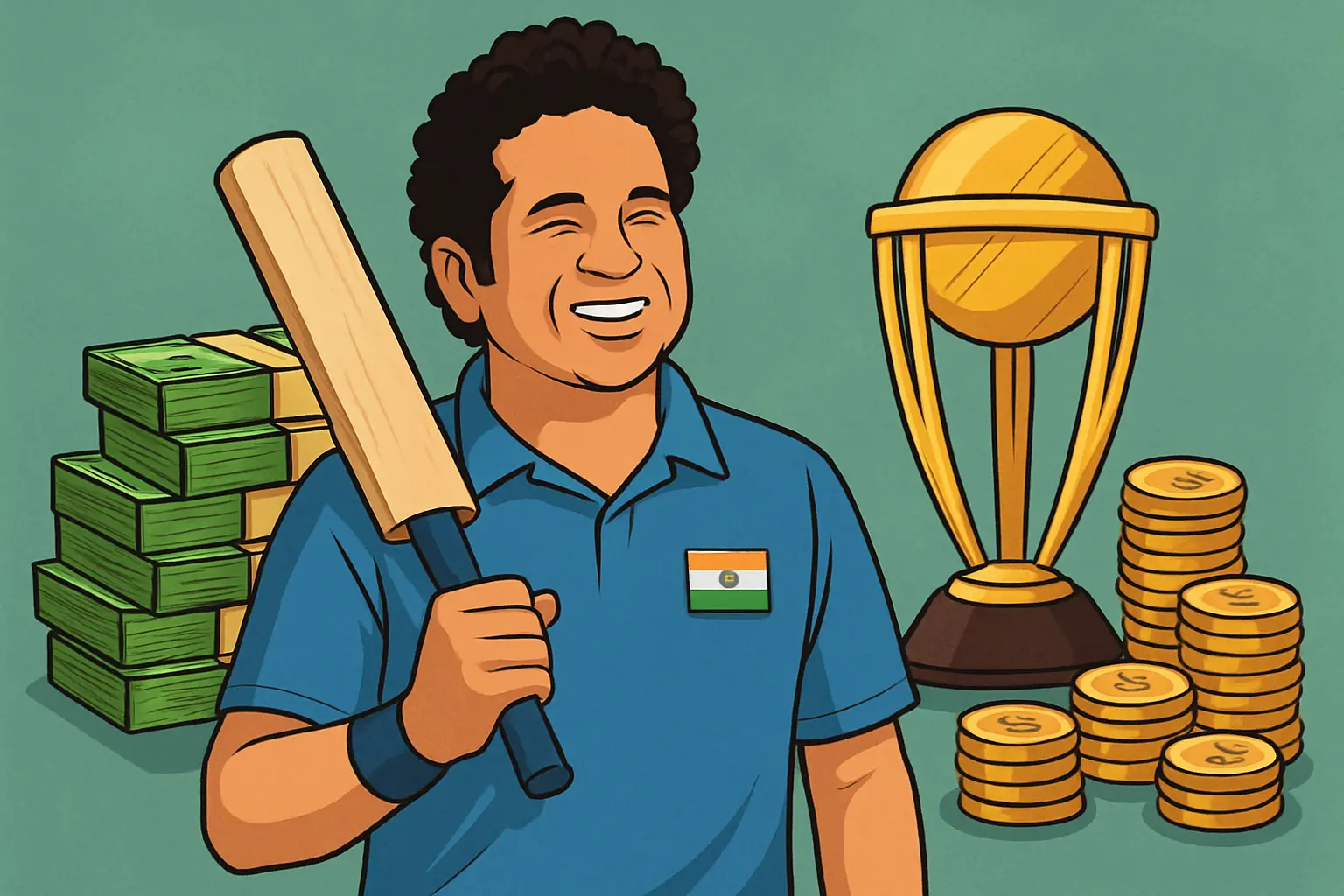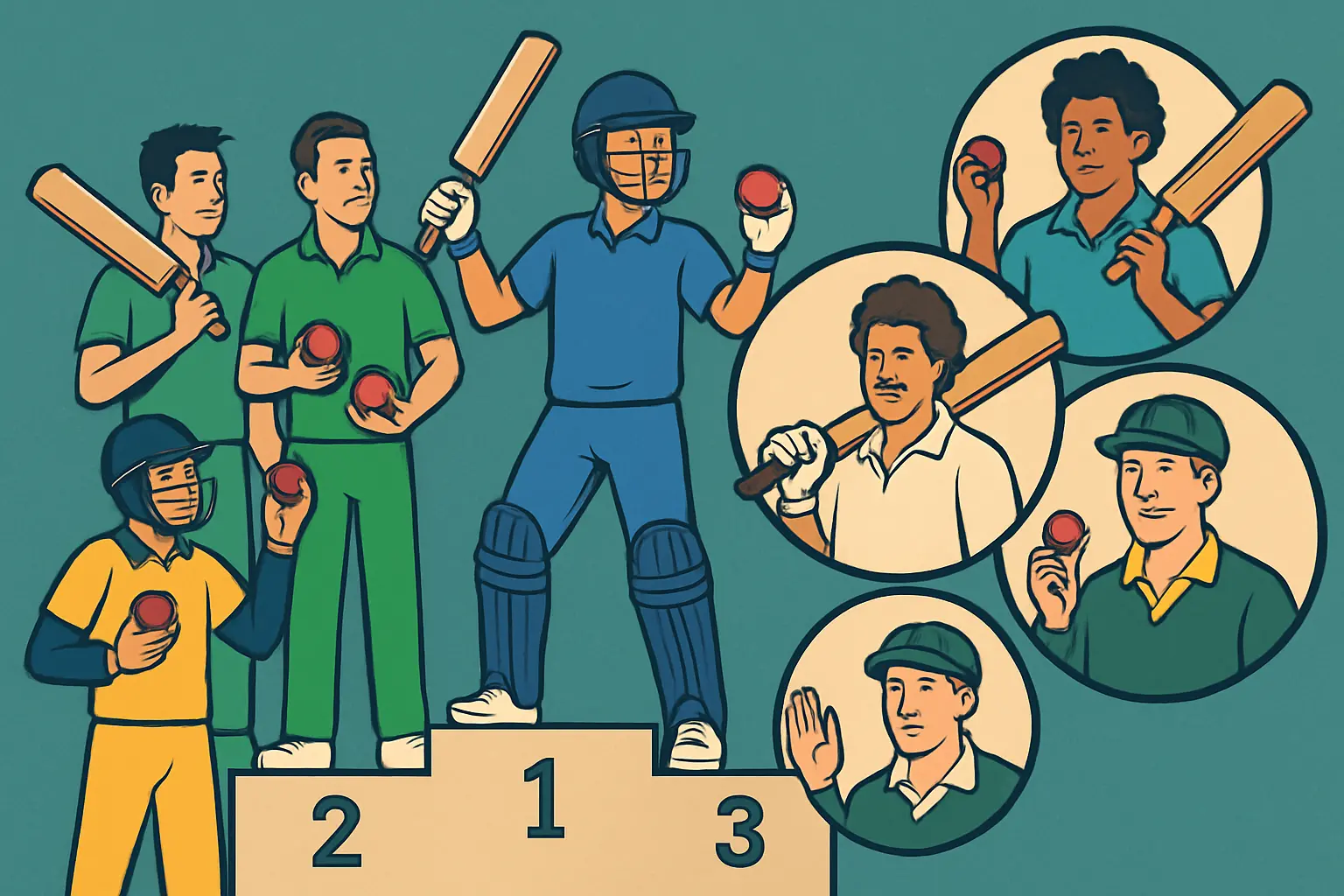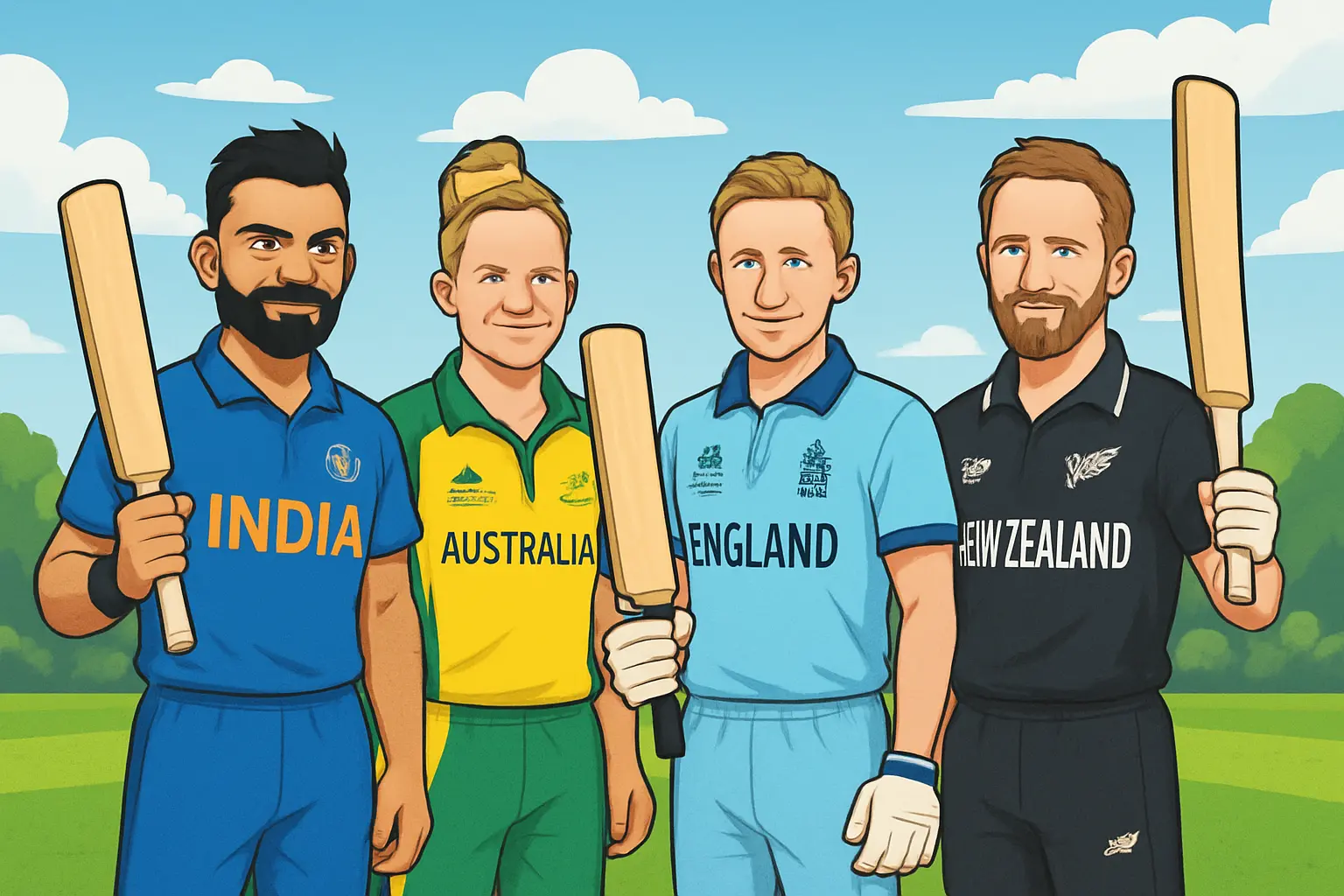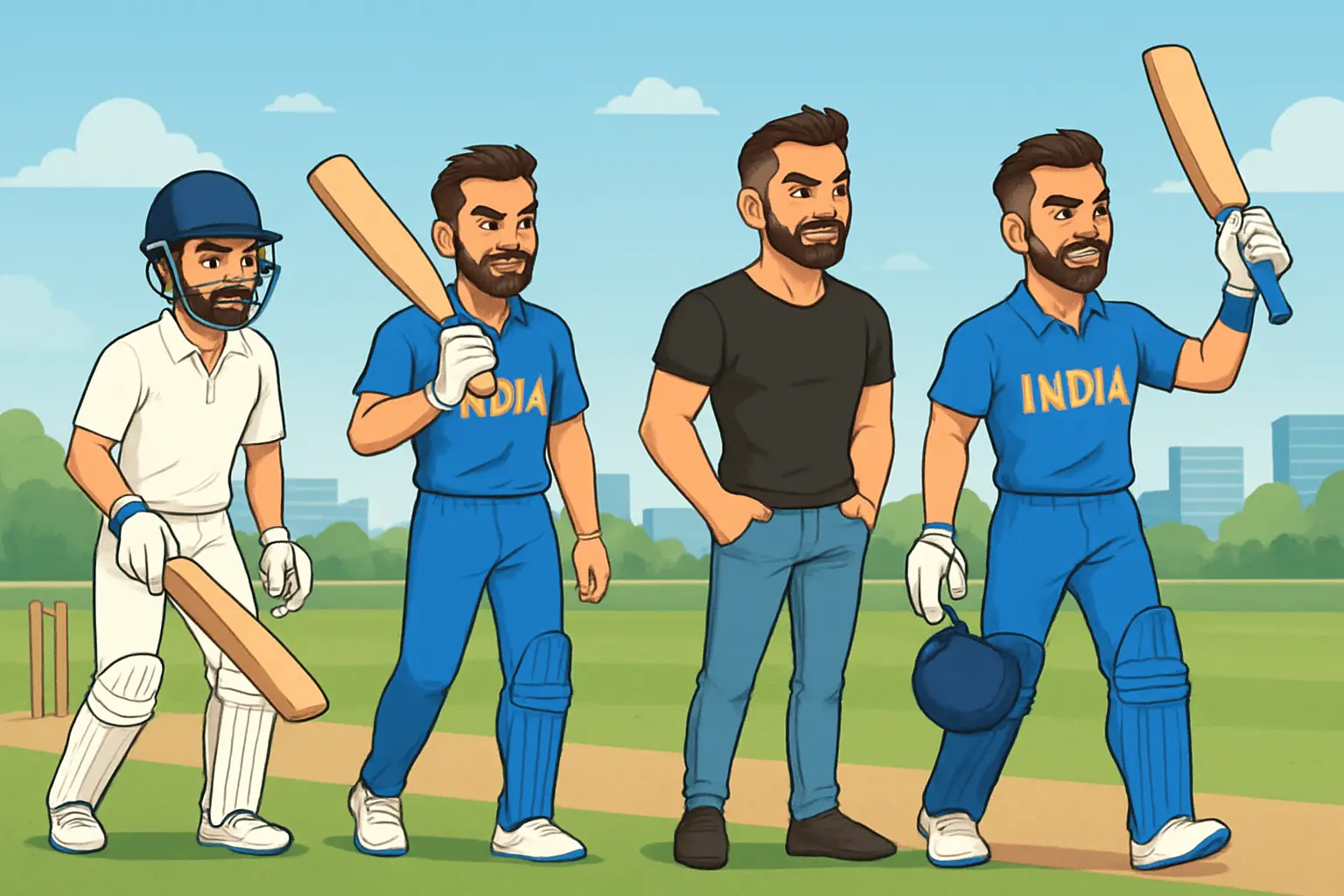Short answer for those who came for the headline
Sachin Tendulkar is the richest cricketer in India. Conservative estimates place his net worth in the INR 1,200–1,700 crore range (roughly USD 145–205 million), built on a foundation of unmatched longevity, evergreen endorsements, and quietly compounding investments and business stakes.
This ranking is grounded in publicly reported BCCI retainers and match fees, IPL contract histories, known brand deals, equity disclosures, and reputable business media reporting, along with sensible assumptions on taxes, lifestyle outlay, and long-run investment returns. It is updated after each IPL auction cycle, central contract revision, and major endorsement or business announcement.
Why wealth in Indian cricket looks the way it does
Indian cricket has a financial architecture unlike any other sport in the country. It sits at the intersection of broadcast money, market-scale brand dollars, and a ferociously loyal consumer base that treats its icons like family. Salaries matter, but salaries alone rarely explain fortunes. The big drivers are endorsements, equity in brands, business ventures, and real estate. And when a player’s reputation ages well, the commercial tail keeps wagging long after the cover drives have ended.
How this list is estimated and why ranges matter
- Income sources included:
- BCCI central contract retainers and international match fees
- IPL franchise contracts including auction prices, renewals, and retention bonuses
- Endorsements and sponsorship income across categories like sportswear, auto, fintech, FMCG, telco, beverages, and consumer tech
- Equity stakes and profit shares in apparel labels, athleisure collaborations, fitness chains, nutrition brands, startups, and sports franchises
- Coaching, commentary, and media gigs
- Business ventures and real estate holdings
- Adjustments made:
- Taxes, agent fees, and standard expenses
- Investing behaviour typical to Indian athletes: debt-free home portfolios, conservative fixed-income allocations, and a few calculated equity bets
- Longevity of brand value and licensing revenue beyond playing days
- Sources of signal:
- Public BCCI pay slabs and match fees
- IPL auction figures and press statements
- Kroll/Duff & Phelps brand valuation analyses of Indian celebrities and athletes
- Disclosures by companies and reputable business media interviews
- Announced equity stakes, co-ownerships, and venture investments
All numbers are estimates expressed as ranges to reflect private holdings and undisclosed valuations.
Top 10 richest Indian cricketers across eras
This is the all-time list that blends earnings across playing careers, post-retirement commercial runs, and business holdings. INR figures are presented first for relevance, followed by USD estimates.
Table: richest Indian cricketers (all-time)
| Rank | Name | Net Worth (INR) | Net Worth (USD) | Status |
|---|---|---|---|---|
| 1 | Sachin Tendulkar | INR 1,200–1,700 crore | USD 145–205 million | retired |
| 2 | Virat Kohli | INR 1,000–1,250 crore | USD 120–150 million | active |
| 3 | MS Dhoni | INR 900–1,100 crore | USD 108–132 million | IPL-active |
| 4 | Sourav Ganguly | INR 450–650 crore | USD 54–78 million | retired |
| 5 | Rohit Sharma | INR 350–450 crore | USD 42–54 million | active |
| 6 | Yuvraj Singh | INR 250–350 crore | USD 30–42 million | retired |
| 7 | Sunil Gavaskar | INR 250–350 crore | USD 30–42 million | retired |
| 8 | Rahul Dravid | INR 230–300 crore | USD 28–36 million | retired, coaching |
| 9 | Virender Sehwag | INR 200–280 crore | USD 24–34 million | retired |
| 10 | Kapil Dev | INR 200–300 crore | USD 24–36 million | retired |
Close contenders and rising fortunes
- Ravindra Jadeja, KL Rahul, Shikhar Dhawan, Jasprit Bumrah, and Rishabh Pant have accumulated significant wealth propelled by IPL contracts, A-grade BCCI retainers, and endorsements in the growing fintech, athleisure, and consumer electronics categories.
- Anil Kumble, Zaheer Khan, and Harbhajan Singh combine playing-era wealth with commentary, coaching, academies, and business holdings.
- Hardik Pandya sits on the cusp of the top bracket thanks to premium IPL contracts and a busy endorsement calendar.
Mini profiles and what actually drives each fortune
Sachin Tendulkar
The story: No Indian athlete commands intergenerational goodwill like Sachin. His endorsements have run across three decades, cutting through categories and cycles. Even when he steps into a room, the temperature of a brand pitch drops by ten degrees. The value is trust.
Money mix:
- Endorsements that never quite stopped; licensing across collectibles, tech, fintech, insurance, and autos
- Early sports investments and franchise co-ownerships that grew in value before mature exits
- Quiet real-estate bets in Mumbai and beyond
- Content and IP around his name that keeps generating residuals
Why the lead keeps compounding: The brand never dipped. He is a category of one, unaffected by form, captaincy debates, or off-field storms. Long-term compounding through conservative investing pushes him ahead of newer earners despite their higher annual cash flow.
Virat Kohli
The story: The most marketable Indian athlete of the modern era, period. Peak fitness, a crafted global image, a fire that broadcasters can package, and a social footprint brands crave.
Money mix:
- Premium endorsements across global and Indian brands; social and digital integrations that carry a price tag of their own
- Equity-heavy deals in fashion and athleisure collaborations like One8 and Wrogn, gym chains and fitness tech tie-ups, food and beverage plays, and early-stage startup bets
- BCCI A+ retainer, match fees, and premium IPL contracts
X-factor: Brand valuation reports routinely slot Kohli as India’s most valuable celebrity endorser. He does not need to bat an eyelid to land a marquee campaign; he often takes equity over cash, and that compounding can outrun salary math in a few years.
MS Dhoni
The story: Ice-veins, captain cool, India’s greatest finisher, a marketer’s dream beyond metro India. Dhoni’s appeal touches tier-2 and tier-3 wallets like nobody else in cricket.
Money mix:
- Endorsements across motorcycles, beverages, fintech, edtech, and consumer staples
- Co-ownership of Chennaiyin FC, the SEVEN athleisure brand, and a portfolio of investments in drones and fintech ventures
- Long-running IPL captaincy contracts with leadership premiums and performance bonuses
Why the number holds: While annual endorsement volume may ebb and flow, Dhoni’s name sells. He has deliberately stayed away from overexposure, which keeps rates high and the brand clean.
Sourav Ganguly
The story: The captain who changed India’s body language. Post-retirement, he dialed up presence in broadcast rooms and boardrooms alike.
Money mix:
- High-value endorsements with banking, FMCG, and education brands
- Stints in cricket administration and television that keep cash momentum strong
- Real estate and advisory roles
The differentiator: Ageless ad-recall in eastern India with national crossover appeal, plus the gravitas of leadership positions.
Rohit Sharma
The story: The captain of calm elegance, five-time IPL title man, a fluent hitter whose form translates well to brand scripts.
Money mix:
- Endorsements across sportswear, electronics, edtech, and finance
- Top-tier IPL contracts and BCCI A+ earnings
- Investments in sports tech and consumer brands
Why it sustains: A clean public persona and consistent presence at the top keep him in the upper ad tier.
Yuvraj Singh
The story: One of India’s most loved cricketers, six-sixes folklore, and a cancer-survivor narrative that brands respect.
Money mix:
- Endorsements with a cause-oriented halo
- YouWeCan Ventures, an early-stage investment vehicle with multiple exits and ongoing stakes
- Legacy contracts and business ventures
Strength: Strong equity strategy; the investment portfolio keeps the number healthy long after playing days.
Sunil Gavaskar
The story: The original run-machine. The voice of Indian cricket for broadcast generations.
Money mix:
- Top-tier commentary and media deals for decades
- Endorsements in classic categories and recurring appearances in cricket-linked programming
The kicker: Steady, long-duration media income that many of his playing-era peers never accessed.
Rahul Dravid
The story: The Wall on the field, the oracle in development rooms. Coaching tenure at the highest level plus NCA and age-group systems cemented his off-field stature.
Money mix:
- Coaching salary at the national setup and previous assignments
- Endorsements that prize credibility and discipline
- Advisory roles and speaking
Advantage: Unimpeachable reputation translates to stable, premium brand work.
Virender Sehwag
The story: Fearless opening, fearless opinions. Sehwag’s digital-first persona became a brand in itself.
Money mix:
- Commentating and digital content monetization
- Endorsements, academies, and local investments
Edge: Highly engaged social following, quick-witted content that brands love.
Kapil Dev
The story: India’s original World Cup icon. Patron saint of self-belief.
Money mix:
- Endorsements that cherish nostalgia and trust
- Business ventures, golf-driven hospitality appearances, and speaking engagements
Longevity: A classic brand with evergreen recall.
Active versus retired wealth leaders
Separating players by current playing status clarifies two different economic engines. Active cricketers swing through high annual cash flow cycles with IPL and brand bursts. Retired legends lean on long-tail endorsements, media, and investments.
Top active Indian cricketers by estimated net worth
- Virat Kohli — INR 1,000–1,250 crore
- Rohit Sharma — INR 350–450 crore
- Hardik Pandya — INR 200–300 crore
- Ravindra Jadeja — INR 150–220 crore
- KL Rahul — INR 150–220 crore
- Rishabh Pant — INR 120–200 crore
- Jasprit Bumrah — INR 100–160 crore
- Shikhar Dhawan — INR 120–180 crore
- Ravichandran Ashwin — INR 120–160 crore
- Suryakumar Yadav — INR 70–110 crore
Top retired Indian cricketers by estimated net worth
- Sachin Tendulkar — INR 1,200–1,700 crore
- MS Dhoni — INR 900–1,100 crore (IPL-active but retired internationally)
- Sourav Ganguly — INR 450–650 crore
- Sunil Gavaskar — INR 250–350 crore
- Rahul Dravid — INR 230–300 crore
- Virender Sehwag — INR 200–280 crore
- Kapil Dev — INR 200–300 crore
- Anil Kumble — INR 100–150 crore
- Zaheer Khan — INR 90–130 crore
- Harbhajan Singh — INR 80–120 crore
Richest by role and leadership
Richest Indian cricket captain
Sachin Tendulkar, Virat Kohli, and MS Dhoni dominate this category by sheer scale. For pure captaincy-era commercial peaks tied to trophies and narratives, Dhoni’s arc captured mass India like nothing else. For compounding and global appeal, Kohli edges the modern cohort. For all-time, Tendulkar’s enduring portfolio keeps him ahead.
Richest Indian wicketkeeper
MS Dhoni stands alone. The wicketkeeper role by itself does not drive wealth; Dhoni’s leadership, match-finishing aura, and pan-India endorsement pull do.
Richest Indian bowler and batsman
Batsmen, especially captains and openers, have historically attracted more brand money. Among bowlers, Anil Kumble and Ravichandran Ashwin lead on cumulative wealth due to longevity, media presence, coaching, and business roles.
Among batsmen, Tendulkar, Kohli, and Rohit Sharma headline the list.
Richest Indian women cricketers
The women’s game in India now rides a sharper commercial curve. Equal international match fees, a franchise league, and a virtuous cycle of prime-time visibility have changed the money map. Endorsement categories are shifting from niche to mainstream, and the leadership tier is expanding.
Table: leading Indian women cricketers by estimated net worth
| Name | Net Worth (INR) | Key drivers |
|---|---|---|
| Smriti Mandhana | INR 40–55 crore | High-value WPL contract, endorsements in sportswear, autos, FMCG, and personal care |
| Harmanpreet Kaur | INR 35–45 crore | WPL contract, captaincy-led brand positioning, banking and consumer brand deals |
| Mithali Raj | INR 30–45 crore | Legacy endorsements, media roles, advisory presence |
| Shafali Verma | INR 12–20 crore | Young star upside; performance-led brand momentum |
| Jemimah Rodrigues | INR 10–18 crore | Digital-first personality with rising endorsements |
The women’s leader in India sits a distance from the men’s top names for now, but the delta is shrinking with every broadcast cycle.
How Indian cricketers actually make money
BCCI central contracts and match fees explained
BCCI retainers are the spine of annual earnings for contracted players. The slabs are simple and transparent.
Table: BCCI annual retainer and international match fee
| Category | Amount |
|---|---|
| Central contracts | |
| Grade A+ retainer | INR 7 crore |
| Grade A retainer | INR 5 crore |
| Grade B retainer | INR 3 crore |
| Grade C retainer | INR 1 crore |
| International match fees (men and women, equalized) | |
| Test | INR 15 lakh per match |
| ODI | INR 6 lakh per match |
| T20I | INR 3 lakh per match |
Domestic match fees vary by experience slabs and tournament. Senior pros can gross a strong mid-seven-figure sum over a full red-ball and white-ball domestic season, but the leap to eight figures and beyond typically requires IPL or international selection.
IPL contracts and the franchise money cascade
An IPL deal is at once a salary, a signal, and leverage in negotiation rooms. Top Indian contracts hover at INR 15–18 crore per season for retained stars and marquee auction wins. Endorsements usually spike with marquee teams, captaincy roles, and playoff storylines.
Table: IPL salary dynamics for Indian stars
| Bracket | Salary per season | Examples |
|---|---|---|
| Elite bracket | INR 15–18 crore | Examples across cycles: long-term deals for top India captains, senior batters, and leadership all-rounders |
| Upper mid bracket | INR 10–14 crore | Proven match-winners, all-format mainstays |
| Mid bracket | INR 5–9 crore | Rising stars, role specialists with consistent output |
| Lower bracket | INR sub-5 crore | Debuts, developmental picks, tactical squad depth |
Winning contexts, clutch performances, and fitness narratives influence renewals. Franchise deals sometimes include leadership bonuses, brand integrations, and post-season marketing work that pay outside the cap.
Why endorsements dwarf salaries at the very top
At the summit, brand money overwhelms base salaries. A Kohli or Dhoni endorsement slate can land eight figures per year in INR terms, sometimes with equity add-ons that convert into outsized gains. The real multiplier is a deal structure where a cricketer trades cash fees for a slice of the company in consumer categories with compounding upside. One breakout brand and a liquidity event can eclipse two IPL cycles of salary in an afternoon.
Who earns the most from endorsements in India
Virat Kohli has the biggest endorsement engine in Indian sport. High recall, a fitness-first image, global social reach, and dependable TV presence make his rate card the benchmark. Dhoni’s rapport with India beyond metros commands its own premium, especially for mass-market products and financial brands. Tendulkar’s endorsements are fewer but blue-chip and timeless. Rohit Sharma and Hardik Pandya hold robust mid-to-upper tier slates, with Rohit’s leadership helping him cross categories.
Richest Indian cricketer without an IPL era advantage
Sunil Gavaskar built elite wealth before franchise cricket existed, then extended it with decades of commentary and media work. In a without-IPL lens, he stands well above his contemporaries due to sustained broadcast leadership and a trusted brand persona.
Richest Indian cricketer under thirty
The younger bracket is led by Rishabh Pant when viewed through a blend of BCCI retainers, IPL contracts, and endorsements in fintech, beverages, and consumer electronics. Shubman Gill and Ishan Kishan follow, propelled by leadership roles within franchises, white-ball visibility, and fashion-forward collaborations. The exact order can shuffle with a single auction or a breakout international season.
Richest Indian domestic cricketer without IPL or international exposure
Domestic-only earnings, while improved, do not push a player anywhere near this list. Match fees, state association support, and local endorsements can deliver a comfortable income, but transformative wealth in Indian cricket requires the twin engines of IPL and international visibility. Some stalwarts supplement with coaching, academies, and institutional roles, but the scale remains modest compared to national-team regulars.
The business play that separates the leaders
Equity, not just endorsements, is where fortunes grow legs.
- Sachin Tendulkar kept early stakes in sports and consumer brands, with selective exits and enduring licensing.
- Virat Kohli took meaningful positions in fashion and athleisure labels attached to his persona, along with targeted startup bets in nutrition, beverages, and fitness tech.
- MS Dhoni co-founded and fronted an athleisure brand, invested in a drone company, and tied up with fintech solutions with nationwide reach.
- Yuvraj Singh institutionalized investment through YouWeCan Ventures, backing consumer-facing startups with multiple successful outcomes.
- Rohit Sharma and Hardik Pandya maintain diversified portfolios anchored in real estate and consumer categories that track their audience.
The richest Indian cricket coach cohort
National-team head coaches at the top of the pay scale build on legacy wealth from playing days and endorsements. Rahul Dravid and Ravi Shastri dominate this space. Their combined coaching assignments, broadcast work, and advisory roles put them far ahead of state and domestic coaches.
India versus the world in cricket wealth
India’s largest markets, gigantic broadcast deals, and a franchise ecosystem with stable capital mean Indian cricketers often top global lists. Add to that a consumer base that treats cricketers as cultural anchors. When an Indian icon scales across North, West, South, and East with equal warmth, the endorsement pie expands beyond what most other cricketing nations can offer. A handful of global stars from other countries with long T20 franchise careers do well, but India’s top three sit comfortably on the podium in any global cricket wealth conversation.
BCCI money versus IPL money versus everything else
- BCCI retainers and match fees are predictable, foundational cash flow. They underpin lifestyle, allow conservative investing, and create a safety net.
- IPL money is seasonal but chunky. It pulls the player into nationwide marketing cycles that create new brand deals and social momentum.
- Endorsements and equity are the real accelerants. They depend on more than strike rates. Likeability, grace under pressure, and good timing in front of the camera matter.
- Business ventures and real estate turn spikes into compounding, shielding athletes from the volatility of form and selection.
The richest Indian cricketer of all time, explained
Tendulkar’s lead is the sum of three advantages:
- Longevity at the very top with minimal brand volatility
- Early-mover advantage in endorsements before the market got crowded, plus intelligent, low-drama curation of brand associations
- Conservative, compounding investment behaviour often observed among high-earning Indian athletes of his era
Many lists shuffle Dhoni and Kohli in second and third. Annual income leaders will sometimes show Kohli above everyone else due to endorsement cadence, especially when counting social media licensing. Lifetime wealth, however, still tilts to Tendulkar for now.
The richest Indian cricketer among bowlers
Anil Kumble and Ravichandran Ashwin stand out. Kumble’s post-playing career spanned coaching assignments, administration, and business roles. Ashwin’s long-format success, commentary-ready presence, and digital content savvy give him a modern monetization edge. Both benefit from a fanbase that respects cerebral cricket.
The richest Indian cricketer by city influence
- Mumbai has produced wealth compounding through sport and finance networks: Tendulkar, Rohit Sharma.
- Delhi’s market scale and national-media visibility drive Kohli’s endorsement dominance.
- Ranchi’s Dhoni is the most powerful story of aspiration in non-metro India and remains unmatched in that lane.
How brands choose their cricketers and why fees differ
- Role and image: Captains and openers bat through the ad breaks. Finishers and crafty bowlers can trend, but leadership roles lock bigger retainers.
- Story: Triumphs after setbacks, composure in storms, family-oriented narratives, and fitness transformations tug at India’s heart and brand budgets.
- Category fit: Athleisure wants athleticism. Banking wants trust. Edtech wants discipline. Food and beverage care about warmth and reach.
- Deliverables: A hard-working ambassador who shows up for shoots, posts on schedule, and stays away from off-field trouble becomes a long-term retainer, not a one-campaign flyer.
The flow of cricket money into equity
Cash fees pay the bills. Equity makes fortunes. The smart play that more Indian cricketers choose today:
- Anchor with 3–5 marquee endorsements for stability
- Take minority equity stakes in two or three high-velocity consumer startups
- Seek revenue share in athleisure or nutrition collaborations where a personal brand lifts sales
- Diversify real-estate exposure across home base and a second city
- Back causes and foundations to stabilize public trust and social license
Why wealthy cricketers build academies and sports IP
Beyond giving back, academies create funnels for apparel deals, camps, content, and tech partnerships. A successful academy network is a recurring revenue asset. It also preserves relevance, which sustains endorsement friendliness.
The tax and cash-flow reality behind the headlines
- Central contracts pay in predictable tranches. IPL pays on schedule through the season.
- Endorsements often come in stage payments queued to deliverables.
- Taxes and agent fees trim every cheque; smart planning ensures that investments happen before lifestyle creep.
- A cricketer’s true wealth story is written in the off-season, in boardrooms with advisors measuring risk and timeline.
Regional-language edge and connection with Bharat
India’s richest cricketers do not speak to just one India. They speak to many Indias.
- भारत का सबसे अमीर क्रिकेटर: सचिन तेंदुलकर. यही सीधी बात है. (India’s richest cricketer: Sachin Tendulkar. That’s the straight talk.)
- इंडिया का सबसे अमीर क्रिकेटर कौन: लंबे समय की कमाई, भरोसेमंद ब्रांड्स, और शांत निवेशों का नाम—तेंदुलकर. (Who is India’s richest cricketer: long-term earnings, reliable brands, and quiet investments—Tendulkar.)
- सबसे अमीर भारतीय महिला क्रिकेटर: स्मृति मंधाना वर्तमान में शीर्ष पायदान पर, हारमनप्रीत और मिताली नज़दीक. (Richest Indian woman cricketer: Smriti Mandhana currently at the top, Harmanpreet and Mithali close.)
Regional resonance matters. Dhoni’s grip on heartland India, Kohli’s pan-India modern appeal, Rohit’s family-friendly warmth—these intangible hues carry real rupee value.
A closer look at roles that print money
Openers and captains
More balls faced equals more screen time, which equals more ads. Captains add leadership aura, post-match podium visibility, and narrative dominance.
Wicketkeepers
The keeper-batsman template exploded with Dhoni. Those who follow inherit a path to wealth: Rishabh Pant, KL Rahul when in the role, and Ishan Kishan in T20 contexts.
All-rounders
An all-rounder changes game geometry and commercial perception. Hardik Pandya’s rise underscores how impact per ball turns into premium brand recall.
Spin maestros
India’s love affair with spin bowling gifts longer careers and commentary relevance. Ashwin’s eclectic mind and content cadence keep his brand modern.
Fast bowlers
Pace icons now sell speed as a lifestyle metric. Bumrah’s precision and calm carry unique branding appeal aligned with high-performance categories.
A tactical detour into brand valuation logic
Brand valuation firms look at:
- Social reach and engagement quality, not just follower counts
- On-screen minutes in high TRP matches
- Sentiment analysis and press exposure
- Cross-category endorsement breadth and exclusivity
- International resonance
Kohli’s consistency across all lanes keeps him on top of the endorsement ladder. Tendulkar remains a gold-standard halo brand. Dhoni’s tier-2 and tier-3 pull is a secret weapon for categories that chase Bharat over Instagram.
Why some fortunes jump suddenly
- A blockbuster exit from a startup investment
- A new long-term brand master agreement across multiple categories
- A franchise move that reboots relevance
- A viral season defining a player’s narrative for years
What does not show up on spreadsheets
- The handshake dividend: An athlete who honours commitments becomes the default choice in brand rooms
- The silence premium: Fewer controversies mean more conservative categories line up to pay
- The family effect: Spousal and family brands that complement public image extend reach into lifestyle categories
Frequently searched topics, answered plainly
Who the richest cricketer in India is right now
Sachin Tendulkar sits at the top on lifetime wealth.
How a cricketer’s net worth is calculated
Add up earnings from BCCI contracts, IPL salaries, endorsements, equity stakes, business ventures, and real estate; subtract taxes and expenses; account for appreciation in investments. Use ranges to reflect private valuations.
Richest Indian cricketer without IPL
Sunil Gavaskar leads, supported by long-term commentary and endorsements.
Which Indian cricketer earns most from endorsements
Virat Kohli leads the endorsement race on rate card and volume.
Richest Indian cricketer among active players
Virat Kohli leads among active internationals by lifetime wealth; MS Dhoni remains a commercial giant through the IPL.
Highest paid Indian cricketer in a franchise season
Premier contracts for Indian stars sit in the INR 15–18 crore band per season; leadership roles and long-sitting retentions occupy the top slots.
BCCI match fee and annual retainer in brief
Retainers: A+ at INR 7 crore, A at INR 5 crore, B at INR 3 crore, C at INR 1 crore. International match fees: Test INR 15 lakh, ODI INR 6 lakh, T20I INR 3 lakh.
Richest Indian wicketkeeper
MS Dhoni by a distance on lifetime wealth.
Richest Indian cricket coach
Rahul Dravid and Ravi Shastri stand out by combining national-team coaching pay with legacy brand strength.
Cricketers with notable businesses
- Sachin Tendulkar: sports IP, licensing, invested interests
- Virat Kohli: fashion and athleisure collaborations, fitness, consumer startups
- MS Dhoni: SEVEN, drones, fintech investments, franchise co-ownership
- Yuvraj Singh: YouWeCan Ventures
- Rohit Sharma: real estate and consumer brand stakes
- Virender Sehwag: academies and media IP
A clear view of risk and resilience
Wealth in cricket is not linear. Injuries, form dips, and selection calls jolt the curve. The resilient wealth arc belongs to those who:
- Diversify early
- Prefer equity in rising consumer brands
- Maintain a disciplined personal brand with low reputational risk
- Build IP—academies, content, licensing—that pays in sleep
Why some legends stay forever bankable
A cricketer moves from star to institution when three things come together:
- Achievement with narrative heft
- Consistent conduct
- Cultural resonance beyond sport
Tendulkar has it. Dhoni has it. Kohli has built it.
The path from lakhs to crores for a young cricketer today
- National selection unlocks BCCI retainers and equal match fees
- A breakout IPL season with a top franchise delivers eight-figure salary and television oxygen
- Two or three brand deals in complementary categories stabilize cash flow
- First home, first portfolio, first equity deal
- Long-term representation with an agency that prioritizes fit over frenzy
Why this list will keep evolving
- IPL auction cycles create instant millionaires
- BCCI central contracts reshuffle slabs and match fees
- Startups raise rounds, increase valuations, or list
- Athletes switch teams or take new leadership roles
- A single campaign with a buyback clause or a performance-driven bonus can shift the needle
The short, simple leaderboard recap
- India’s richest cricketer: Sachin Tendulkar
- Closest modern challengers on lifetime wealth: Virat Kohli and MS Dhoni
- Richest captain cohort: Tendulkar, Kohli, Dhoni
- Richest wicketkeeper: MS Dhoni
- Richest bowler: Anil Kumble with a challenge from Ravichandran Ashwin
- Richest woman cricketer: Smriti Mandhana, with Harmanpreet Kaur and Mithali Raj close
- Highest franchise salary band for Indian players: INR 15–18 crore per season
- Biggest endorsement magnet: Virat Kohli
Closing thoughts from a press box regular
Money in Indian cricket follows storylines as much as scorecards. The players who build wealth that lasts understand they are writing a story for two audiences, not one. The first is the scoreboard, ruthless and immediate. The second is the living room, patient and forgiving. Get both right and the numbers accrue in ways no spreadsheet forecasts. Tendulkar still leads because he mastered that balance before anyone else even saw the template. Kohli’s engine roars because he turned discipline into a brand. Dhoni’s aura sells because it calms. Others are rising. The ladder is sturdier than ever.
The richest cricketer in India today is a product of skill, steel, and the simplest of compounding truths. Win trust, keep it clean, own a share of what you sell, and give the country moments it will tell its children about. The money takes care of itself.








